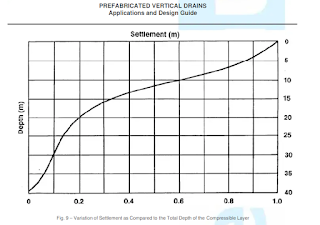Plastic drainage boards are commonly used materials in soft soil foundation treatment.
SUNZO-Ground Improvement Experts
Soft Soil Treatment Specialist, China Wick Drains, Prefabricated Vertical Drains
Friday, December 20, 2024
Prefabricated vertical drains are commonly used materials in soft soil foundation treatment
Vacuum consolidation is a method of soft soil foundation treatment
Vacuum consolidation is a method of soft soil foundation treatment.
The basic principle is to lay a sand cushion layer on the surface of the soft soil foundation that needs to be reinforced, then lay a vertical drainage body such as a plastic drainage board, and then lay an airtight sealing film on the sand cushion layer to isolate it from the atmosphere. The device extracts the air from the soil under the membrane, thereby forming an air pressure difference inside and outside the membrane. This air pressure difference is equivalent to applying a preload load to the foundation, prompting the water in the soil to be discharged, consolidating the foundation, and improving the strength. To achieve the purpose of strengthening the foundation.
Vacuum consolidation usually has the following significant effects:
advantage:
Accelerated consolidation: It can effectively accelerate the consolidation speed of soft soil foundation, allowing the foundation to achieve higher strength and stability in a shorter period of time.
Improve the bearing capacity: It can greatly improve the bearing capacity of the foundation to meet the requirements of subsequent project construction.
Reduce settlement: It can significantly reduce the later settlement of the foundation and ensure the long-term stability of the project.
Wide scope of application: It can be applied to many types of soft soil foundations, such as silt soil, silt, etc.
Vacuum consolidation is mainly suitable for the following ranges:
Silt, silty soil and other weak foundations: Such soft soil layers are widely found in coastal areas, around lakes and other places.
Large-area site reinforcement: such as large-area soft soil foundation treatment in port terminal yards, airport runways, etc.
Projects with higher requirements for deformation control: because it can effectively reduce settlement and uneven settlement.
Foundation treatment in the early stage of the filling project: Reinforce the soft foundation before carrying out the filling construction.
Foundations with higher groundwater levels: can effectively reduce groundwater levels and improve foundation conditions.
Ground improvement vacuum consolidation method
The vacuum consolidation method is to lay a sand cushion on the ground within the soft clay foundation that needs to be reinforced, and then set up a plastic drainage board. The horizontal water filter pipe and vacuum equipment are connected through the plastic drainage board, and an airtight sealing film is covered on it to make the soft soil Isolated from the atmosphere, use a vacuum device to evacuate the air inside the membrane, thus creating an air pressure difference inside and outside the membrane. This part of the air pressure difference becomes a load acting on the foundation. The foundation solidifies as the isotropic stress increases. Knot.
Vacuum consolidation technology is suitable for the reinforcement of soft soil foundations. There are widespread soft clay layers deposited in marine, lake and river phases. This kind of soil is characterized by high water content, high compressibility and low strength. , poor water permeability. Weak clay foundations can undergo considerable deformation or differential deformation under building loads. For weak clay foundations, especially when large-area treatment is required, such as building docks, airports, etc. on soft clay foundations, vacuum preloading method and vacuum stacking combined preloading method are one of the more effective methods for treating such weak clay foundations.
Wednesday, December 4, 2019
THE VERTICAL WICK DRAIN PRINCIPLE AND ITS APPLICATIONS
Wednesday, November 20, 2019
Principles of soft foundation treatment for water dike project
1 Principles of soft foundation treatment for water dike project
1.1 Control the ground settlement index;
1.2 Strictly control PVD construction time;
1.3 To be done in bridge foundation treatment and the soft soil improvement;
1.4 Use appropriate packing.
Tuesday, November 19, 2019
Soft Soil and Soft Based Ground Requires Ground Improvement Before Construction
Soft Soil & Soft Based Ground Requires Ground Improvement Before Construction
Thursday, November 14, 2019
What is Soil Improvement and Its Importance in Dredging Industry
WHAT IS SOIL IMPROVEMENT?
WHY IS SOIL IMPROVEMENT IMPORTANT?
WHAT IS THE DIFFERENCE BETWEEN CONSOLIDATION AND COMPACTION?
Prefabricated vertical drains are commonly used materials in soft soil foundation treatment
Plastic drainage boards are commonly used materials in soft soil foundation treatment. In vacuum preloading and load preloading treatment o...

-
With the rapid development of our social economy, the land resources available for economic construction in the coastal areas are becoming m...
-
Vacuum preloading reinforcement mechanism The vacuum preloading method uses atmospheric pressure as a preloading load. Firstly, a la...
-
Mechanism and Advantages of Vacuum Preloading vacuum preloading 1. Reinforcement mechanism Taking the atmospheric pressure as ...
.jpg)







